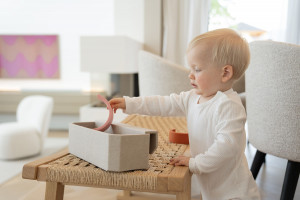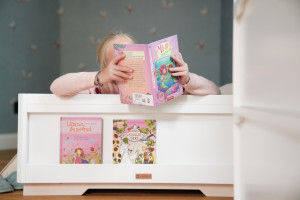Naolima® Journal From what age can a baby sleep in a floor bed?
29. September 2025

Many parents wonder when their baby can safely sleep in a floor bed. Floor beds are becoming increasingly popular – they promote independence, offer greater freedom of movement, and create a cozy, natural sleep environment.
But especially in the first months of life, safety plays a major role. This makes the question of the “right time” an important decision for many families.
In this article, you will learn at what age a floor bed makes sense, what parents should pay attention to, how the transition from a bedside crib or cot can work, and what you should consider to ensure that sleeping in a floor bed is truly safe and relaxing.
As parents, we always want the best for our little ones – especially when it comes to their sleep. One trend that has gained popularity in recent years is the use of floor beds for infants and toddlers.
Compared to traditional cribs, floor beds open up a completely new sleep environment – one centered around freedom, independence, and movement from the very beginning.
Understanding the floor bed concept
Before we look at when your baby can sleep in a floor bed, it’s helpful to understand the idea behind it.
A floor bed is very simple: a mattress placed close to the floor – without bars, without restrictions. The idea is to provide your child with a safe yet free sleep environment. Your baby can crawl into bed independently and get up on their own when they wake up. They can discover their little world at their own pace.
Benefits of a floor bed
Promotes independence
One of the biggest advantages of a floor bed is that it encourages even the youngest children to become more independent. Unlike in a crib, your child is not confined; they can decide when to crawl into bed or get up. This sense of freedom boosts confidence and supports healthy self-esteem.
Supports motor development
Because your baby can move freely in a floor bed, they naturally train their gross and fine motor skills. Whether rolling, crawling, or taking first steps – the floor bed offers space to explore and develop safely.
Ideal for breastfeeding and co-sleeping
If you breastfeed, your baby likes to sleep near you at night, or you practice sleep support, a floor bed can be a real relief. You have quick, comfortable access to your baby without lifting them out of a crib – which leads to calmer nights and strengthens the bond between parent and child.
Encourages more peaceful sleep
Many parents report that their children sleep more calmly in a floor bed. This is often because children learn to self-soothe and return to sleep without constant help.
Easier transition to a regular bed
Children who sleep in a floor bed early on usually find the later switch to a regular bed much easier. They are familiar with the freedom of moving independently and feel safer and more secure.
When is the right time for a floor bed?
After learning about the benefits, you may be wondering when the right time is to start.
Every child develops at their own pace – so there’s no universal rule. However, there are some helpful guidelines:

Around 18–24 months
Many parents choose to transition between 18 and 24 months. At this age, most babies have good head and neck control, making sleep on a flat mattress safer. Make sure your baby can freely move their head and breathe easily.
When your child becomes more mobile
As soon as your baby begins to roll, scoot, or crawl, the floor bed can be a natural next step. They can move freely, get up, or lie back down – without the restrictions of crib bars.
When the crib becomes too small
If your child starts trying to climb out of the crib or seems restless inside it, it may be time to consider a floor bed. This helps prevent falls and improves both safety and freedom of movement.
When it feels right for you
Ultimately, your intuition matters most. You know your child best. If you feel comfortable with the idea of a floor bed and your child seems ready, then now is likely the right time. Trust your instincts – they are often the best guide.
Safety considerations for a floor bed
When switching to a floor bed, one thing is most important: your child’s safety. To ensure your baby can enjoy this new freedom safely, keep the following in mind:
Make the room child-safe
Ensure that the room where the floor bed is placed is completely baby-proofed. Secure furniture to the walls, cover electrical outlets, and remove anything that could pose a danger during play or exploration. Make the area around the bed soft and cozy – a rug or play mat helps cushion falls during early attempts at standing or crawling.
Choose a firm mattress
The mattress should be firm and fit the frame perfectly. It should also be made of breathable, low-toxicity materials.
For our MoveMi® products, specially designed mattresses are available to support the transformation function using a Velcro connection.
Avoid loose bedding
Pillows, blankets, and stuffed animals may look cozy but increase the risk of suffocation. Instead, use a sleep sack or appropriate sleepwear that matches the room temperature.
Ensure a safe sleep position
Always place your baby on their back to sleep – this is a worldwide pediatric recommendation to reduce the risk of Sudden Infant Death Syndrome (SIDS). Studies confirm the link between SIDS and stomach and side sleeping positions. In countries where “Back to Sleep” campaigns were implemented, SIDS rates dropped by 30% to 50%.
Supervise early exploration

A floor bed encourages crawling, standing, and exploring – which is wonderful! But during the first days or weeks, it's important to stay close and observe your child until you are sure everything works safely.
The right bed size for a floor bed
It may be tempting to buy a large “future-proof” bed – for example, 200 × 140 cm. But for babies, this is not a good idea. Why?
First, your baby doesn’t need that much space. A very large sleep surface can make them feel lost or insecure. Babies sleep better when they feel contained and safe.
Second, large beds are designed for older children or adults. They are not suitable for co-sleeping with infants and often don’t meet the needs of newborns.
Smaller floor beds between 160 × 70 cm and 90 cm are much better choices. They offer enough room to move while remaining cozy, manageable, and safe – perfect for the early years.
Conclusion
A floor bed can be a wonderful way to encourage your child’s independence while creating a safe, calm sleep environment. The best time to transition depends entirely on your child’s developmental stage. Often, the right moment comes when your child becomes more mobile or when the crib feels too restrictive.
Safety always comes first. Make sure the sleep area is child-friendly and follows general safe-sleep guidelines. Trust your instincts – you know your child best. The goal is to create a space where your child feels secure, can explore freely, and happily drifts off to sleep.
What age is suitable for a floor bed?
A floor bed is suitable once your child can move safely and freely.
Is there an age limit for floor beds?
There is no fixed age limit. As long as your child feels comfortable and has enough space, they can use a floor bed. With a growing model – such as the one from Naolima – the bed can be used for many years.
From what age is a floor bed appropriate?
There is no minimum or maximum age for a floor-level child’s bed. The right timing depends entirely on the needs of the child and parents.
Many parents choose a floor bed as soon as their child becomes mobile – since the low entry makes it easily accessible even for crawling babies.
From when is a Montessori floor bed recommended?
Maria Montessori believed that a Montessori floor bed could theoretically be used from birth. In practice, however, many parents start with a crib or bedside sleeper to provide closeness and security in the first months.
Where can I buy a Naolima floor bed?
You can purchase our products from selected retailers in Germany, Austria, and the Netherlands – for example in Frankfurt, Düsseldorf, Munich, Berlin, Vienna, or Münster. Our partners will give you personalized advice and help you find the perfect model.